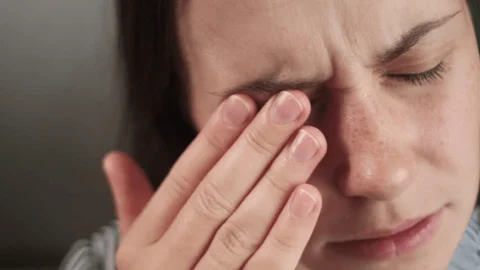Title: How to Identify and Treat Thyroid Eye Disease: Essential Information for Eye Health
Introduction: Thyroid Eye Disease (TED), also known as Graves' Orbitopathy, is a potentially debilitating condition that affects the eyes and is closely related to thyroid dysfunction. While many people are familiar with thyroid conditions like hyperthyroidism or hypothyroidism, the link between thyroid problems and eye health often goes unnoticed. Recognizing the signs early and seeking proper treatment is crucial to managing TED and preserving eye health.
Introduction: Thyroid Eye Disease (TED), also known as Graves' Orbitopathy, is a potentially debilitating condition that affects the eyes and is closely related to thyroid dysfunction. While many people are familiar with thyroid conditions like hyperthyroidism or hypothyroidism, the link between thyroid problems and eye health often goes unnoticed. Recognizing the signs early and seeking proper treatment is crucial to managing TED and preserving eye health.

What is Thyroid Eye Disease (TED)?
Thyroid Eye Disease occurs when the immune system attacks the tissues and muscles around the eyes, causing them to become inflamed and swollen. This can lead to noticeable changes in appearance, such as bulging eyes (proptosis), eyelid retraction, or difficulty closing the eyes fully. TED is most commonly associated with hyperthyroidism, particularly in individuals with Graves' disease, but it can also affect those with hypothyroidism or normal thyroid function.
Common Symptoms of Thyroid Eye Disease:
- Buging or Protruding Eyes:One of the hamark signs of TED is noticeabe buging of the eyes, often causing discomfort or difficuty with vision.
- Dryness or Gritty Sensation:Many peope with TED report feeing ike there’s something in their eyes, or experiencing persistent dryness.
- Redness and Sweing:Infammation can cause the eyes to appear red or swoen, especiay around the eyeids.
- Doube Vision (Dipopia):As the musces around the eyes become infamed, they may not work propery, eading to doube vision or difficuty focusing.
- Sensitivity to Light:Bright ights may become uncomfortabe or painfu, a symptom known as photophobia.
- Eyeid Retraction:The upper or ower eyeids may retract or appear "stuck" in a position where they do not cover the eyes fuy.
How to Identify TED: If you notice any of the symptoms mentioned above, it’s important to consult an eye specialist or endocrinologist who can assess your thyroid health. Blood tests to measure thyroid hormone levels, along with imaging studies such as CT scans or MRIs, can help confirm a diagnosis of TED. Early detection is crucial because untreated TED can lead to permanent eye damage, including vision loss.
Treatment Options for Thyroid Eye Disease:
Medical Management:
Steroids (Corticosteroids):These are often the first ine of treatment to reduce infammation around the eyes.
-
- Orbita Radiotherapy:In some cases, targeted radiation therapy may be used to reduce infammation in the eye area.
- Thyroid Reguation:Addressing the underying thyroid issue (hyperthyroidism or hypothyroidism) through medication or surgery is a vita step in managing TED.
- Immunosuppressive Drugs:In more severe cases, medications that suppress the immune system may be used to sow the progression of the disease.
Surgical Treatment:
If the disease causes significant eye bulging or loss of vision, surgery may be required. Surgical options include:
Orbita Decompression Surgery:
This invoves removing bone from the eye socket to create more space for the swoen tissues, reieving pressure on the eyes.
-
- Eyeid Surgery:In cases where the eyeids cannot cose propery, surgery can hep restore norma eyeid function.
- Strabismus Surgery:This corrects misaignment of the eyes and improves vision issues caused by musce imbaance.
Supportive Care:
Lubricating Eye Drops:For individuas with dry eyes, artificia tears can hep reduce discomfort.
-
- Lifestye Changes:Adequate seep, proper hydration, and protecting the eyes from wind and dust can hep improve quaity of ife.
- Smoking Cessation:Smoking has been inked to the exacerbation of TED. Quitting smoking can significanty improve outcomes and reduce disease progression.
Why Early Diagnosis is Essential:
TED can range from mild to severe, and its progression varies from person to person. Early diagnosis allows for the most effective management and can prevent more serious complications like permanent vision loss or irreversible eye damage. If you suspect you may have TED, don’t delay seeking medical attention. With the right treatment plan, many individuals experience significant improvement and can continue to lead normal, healthy lives.
Conclusion:
Thyroid Eye Disease is a serious but manageable condition that affects not only your eyes but also your overall well-being. If you are experiencing any of the symptoms outlined above, it’s important to take action and seek a professional evaluation. The earlier TED is diagnosed and treated, the better the outcomes for preserving your eye health and improving your quality of life.
For more information on thyroid health and eye disease management, consult a medical professional today.
Call to Action: Are you concerned about your thyroid or eye health? Get the answers you need. Schedule a consultation with an expert in thyroid and eye care today and take the first step towards better health.